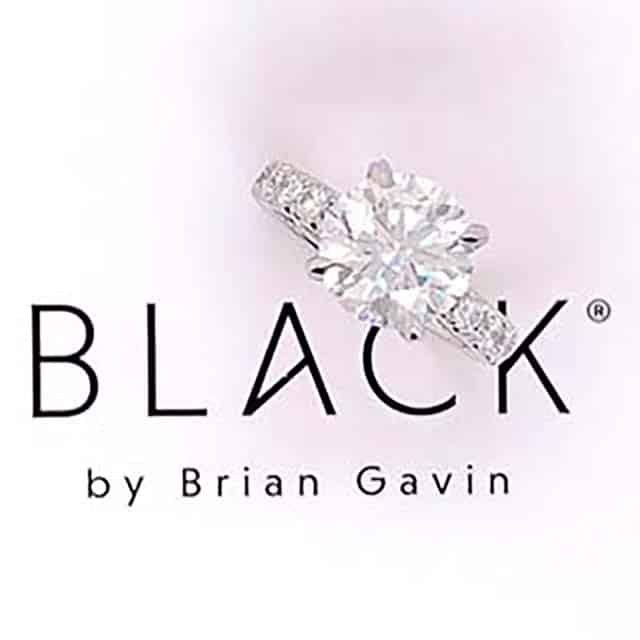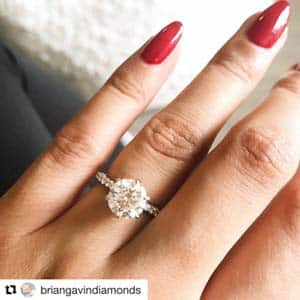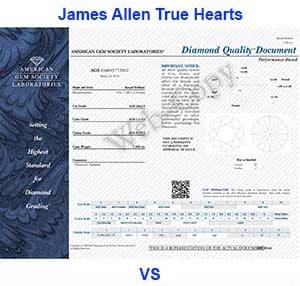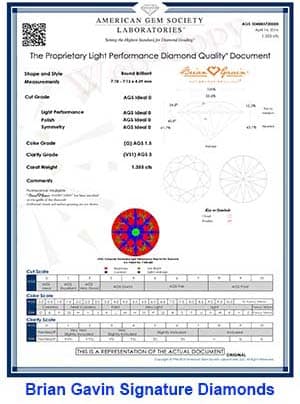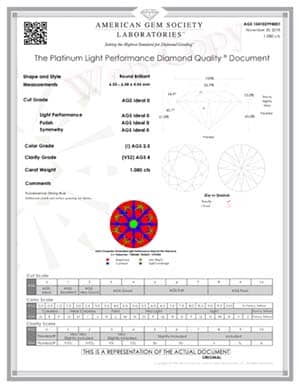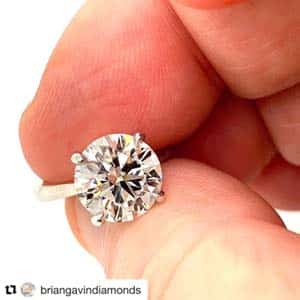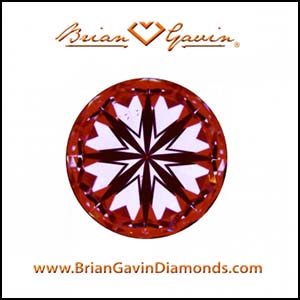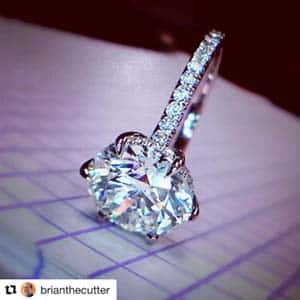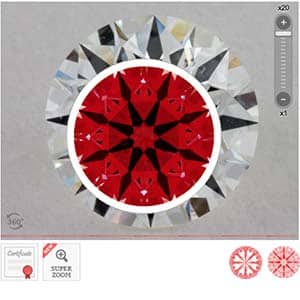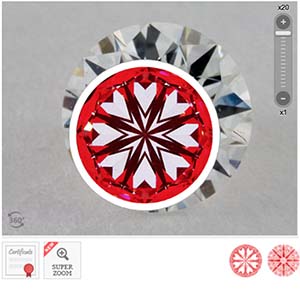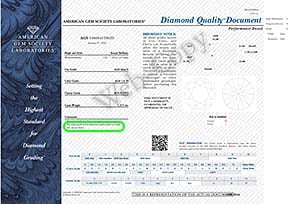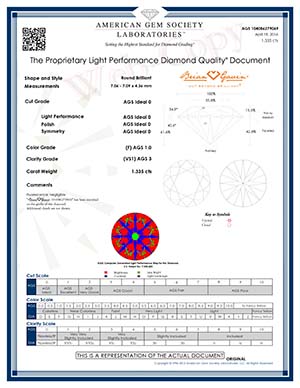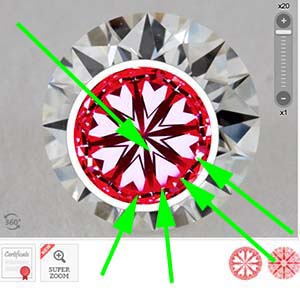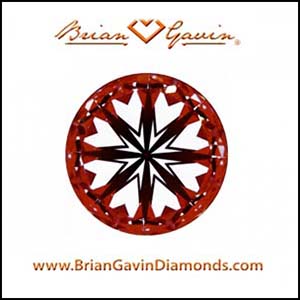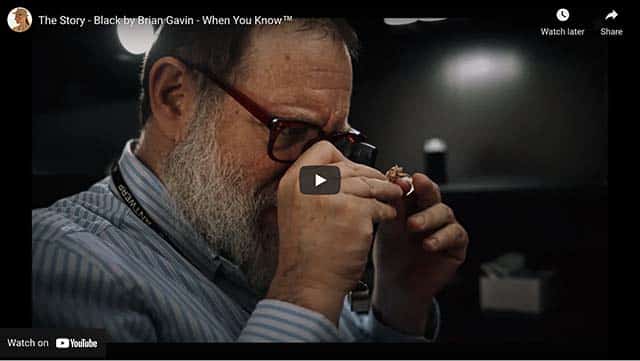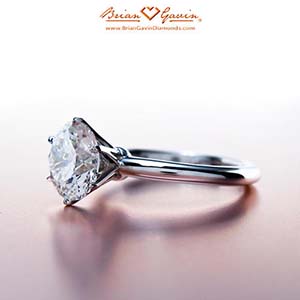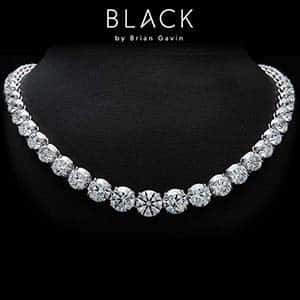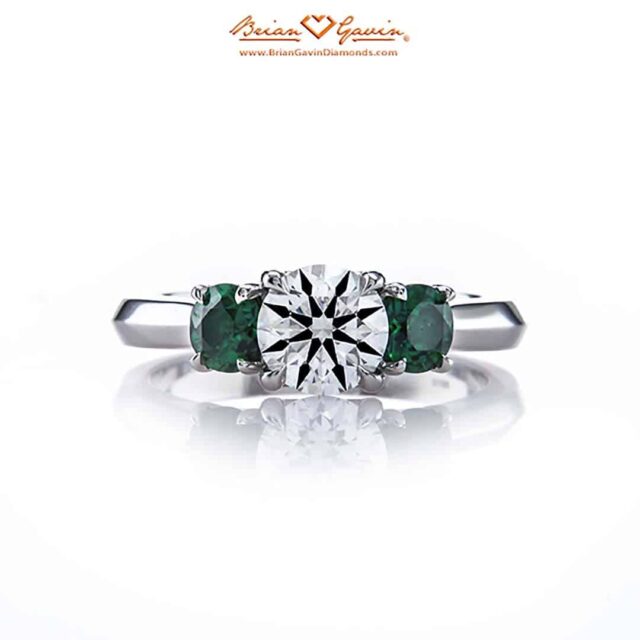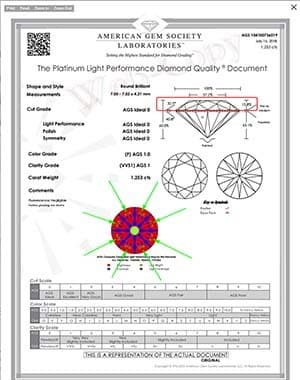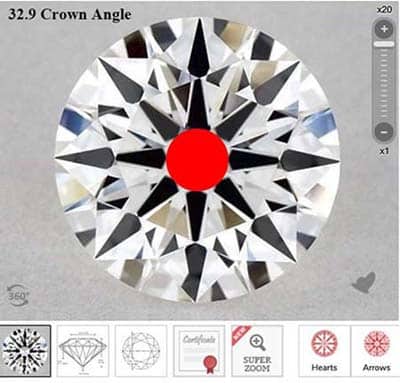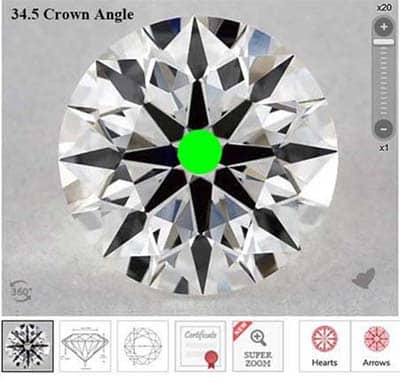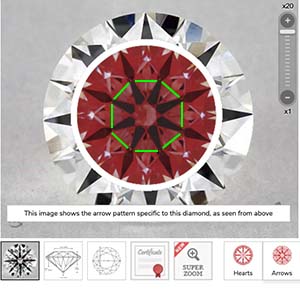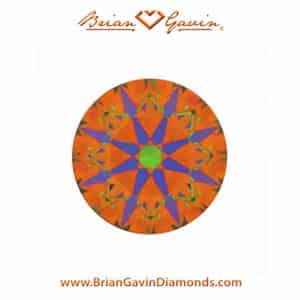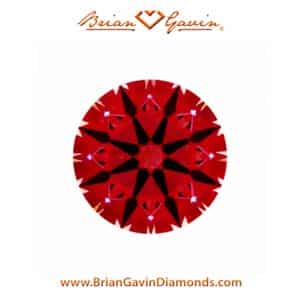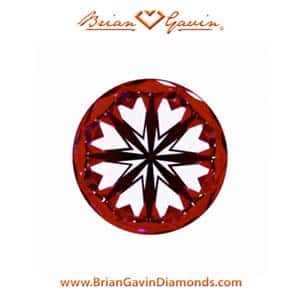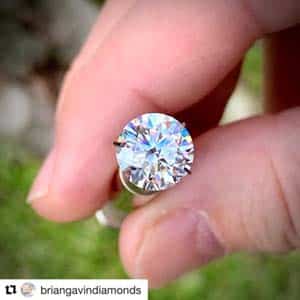This review of James Allen vs Brian Gavin Hearts and Arrows Super Ideal Cut Diamonds was originally written in 2016. However, it has been updated for 2021 to provide you with the most in-depth current insight.
As with most of my blog posts, it was written in response to a question from a client. The original response to that inquiry remains intact below.
However, I’m updating this post in response to questions posed by another client based on the original content of this article.
Here is what the most recent client wants to know:
"How do James Allen True Hearts diamonds stack up against the new Black by Brian Gavin Hearts and Arrows diamonds?” With that in mind, I’ve added the following jump section that will take you to that answer further down the page:
This will be extremely helpful the event that you're trying to decide between James Allen vs Black by Brian Gavin diamonds. In the first place, I'm going to break down the differences and show you what to look for in a diamond. Then, I'm going to demonstrate the difference in light performance between these two popular brands.
The Original James Allen vs Brian Gavin Blog Post:
"What is the reason for the price difference between James Allen True Hearts and Brian Gavin Signature Hearts and Arrows diamonds? There seems to be a pretty steep premium charged by Brian Gavin for his hearts and arrows diamonds."
"Is the premium simply due to a difference in brand name? Or is the difference in price between the two brands of hearts and arrows diamonds due to differences in diamond cut quality?"
"Can you tell me what differences in diamond quality are actually worth paying for? I am trying to decide between these (3) James Allen True Hearts Diamonds, and (5) Brian Gavin Signature diamonds."
"At the end of the day, I simply want a spectacular looking diamond in the range of 1.30 carats, which is completely eye clean, and faces-up white in a platinum six prong solitaire. Can you help me pick the best diamond from the list provided?"
James Allen vs Brian Gavin Diamonds Comparison:
Below is the list of seven hearts and arrows cut diamonds that the client asked me to evaluate:
- 11.308 carat, G-color, VS-2 clarity, James Allen True Hearts.
- 21.314 carat, F-color, VS-2 clarity, Brian Gavin Signature diamond.
- 31.315 carat, F-color, VS-2 clarity, James Allen True Hearts.
- 41.317 carat, H-color, VS-1 clarity, Brian Gavin Signature diamond.
- 51.335 carat, F-color, VS-1 clarity, Brian Gavin Signature diamond.
- 61.348 carat, H-color, VS-1 clarity, James Allen True Hearts.
- 71.355 carat, G-color, VS-1 clarity, Brian Gavin Signature diamond.
Obviously, the client is only going to purchase one of these diamonds. With that in mind, I provided him with in-depth reviews of each diamond via email.
After that we spent some time going back and forth discussing the whole James Allen vs Brian Gavin thing. Then I obtained his permission to publish these reviews and some of the topics we discussed as a blog post.
James Allen vs Brian Gavin Diamond Prices:
In the first place, all of the diamonds featured in these James Allen vs Brian Gavin reviews are AGS Ideal cut. Secondly, all of the diamonds exhibit patterns of hearts and arrows to varying degrees.
As a matter of fact, a professional diamond buyer should be able to discern the differences in cut quality. However, the odds are that the average diamond buyer does not know what to look for and that's the point.
Although that is not to say that you would not be able to appreciate the ideal differences once you've been shown what to look for.
In my experience, when people compare the prices of James Allen vs Brian Gavin, they approach it from this perspective. If both diamonds are meet the following criteria:
Then logic dictates that the diamonds must be comparable, thus the prices for the diamonds should be relatively the same. However, nothing could be further from the truth because a lot of hidden factors can affect diamond prices.
Diamond Price Considerations:
In the first place, very slight differences in optical precision can have a major impact upon the price. Most people in the diamond industry don’t want you to know that Diamond Cut Quality Affects Price by Sixty Percent.
Secondly, a little known factor called Optical Precision has a substantial affect on diamond prices. Although that may be true, the gemological laboratories do not account for optical precision.
As a matter of fact, the symmetry grade on the lab reports on the left is based on meet point symmetry. Whereas optical precision is the consistency of facet shape, size, and alignment from the perspective of 360-degrees.
With this in mind, the differences between the two AGS lab reports on the left becomes even more important. After all, very slight differences in cut quality can have major effects upon the price.
Be that as it may, you also have to take the difference in sparkle factor into account.
As can be seen on the left, the AGS report for this James Allen True Hearts diamond does not contain an ASET map.
Whereas the ASET map is standard on diamond grading reports issued by the AGS for Brian Gavin Signature diamonds.
Given this obvious difference, you might find yourself concluding that James Allen vs Brian Gavin is the difference between Performance Based vs Light Performance Diamond Quality Documents.
James Allen vs Brian Gavin ASET Images:
As a matter of fact, both of the AGS Diamond Quality Documents shown above are Light Performance based. However, the Platinum version of the report that accompanies all Brian Gavin Signature diamonds features an ASET map.
Whereas you're likely to find that only a few of the lab reports for James Allen True Hearts diamonds feature ASET. In the first place, the ASET image provides you with a visual representation or map of how the diamond reflects light.
Secondly, it demonstrates where in the room the diamond is gathering light from. As a matter of fact, it's important to know How to Use an ASET Scope and Interpret the Images. With that in mind, let's take a look at the ASET images for two very different AGS Ideal Cut diamonds:
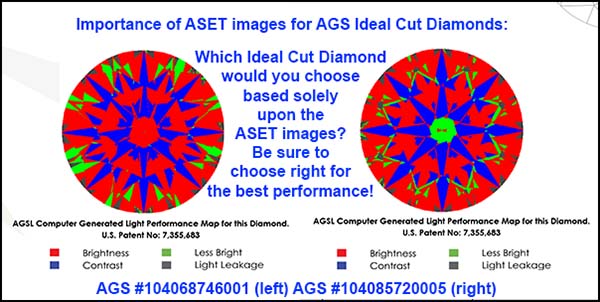
In the first place, I want you to know that I'm making an "Apples to Oranges” comparison of ideal cut diamonds that are on ends of the spectrum. After all, this is the best way to demonstrate the difference in light performance between these two AGS Ideal-0 cut diamonds:
How to Read an ASET Scope Image:
To begin with, the ASET image featured above on the left is a standard ideal cut diamond. While the diamond in the upper right is a Brian Gavin Signature round hearts and arrows diamond. As a matter of fact, both diamonds have an overall cut grade of AGS Ideal-0.
In addition, both diamonds were graded on the Platinum Light Performance grading platform. In that case, you could mistake the diamonds as being comparable based on the paper grade.
After all, with exception of the insight provided by the ASET Scope image, the characteristics are practically the same. In fact, the ASET Scope images are the only reason we know there is a difference in cut quality.
In order to fully appreciate the differences between these two ideal cut diamonds, I strongly recommend reading the following articles:
James Allen ASET Scope Images:
As a matter of fact, James Allen provides Hearts and Ideal Scope images for True Hearts diamonds. Although this may be true, they do not provide ASET Scope images for James Allen True Hearts diamonds.
In the event that you're wondering why this is the case, rest assured that you are not alone. The only workaround at the moment is to limit your search to diamonds graded by the AGS Laboratory.
At the same time, only a few of the results will feature an ASET map on the diamond grading report. With this in mind, you can always try to request an ASET Scope image from James Allen.
However, I can tell you that any requests that I've made for James Allen ASET Scope images has been denied. Vehemently denied as a matter of fact, despite trying to point out that the following vendors provide ASET Scope images:
What makes this more frustrating for me, is that I know that James Allen has the ability to produce ASET Scope images. In other words, they have the ability to provide ASET Scope images, but just won't do it. Apparently not for me, and probably not for you either, but you can go ahead and ask.
ASET Maps on the Lab Reports:
In the first place, you might think that James Allen doesn't want to take the time to photograph the ASET Scope images. However, you should know that it would take less than a second on their state-of-the-art imaging system.
Be that as it may, the cost of adding the ASET map to an AGS Platinum Light Performance report is also minimal. Especially when you consider the benefit that having ASET Scope images would add to the James Allen True Hearts brand.
After all, the ASET map serves to prove their claims based on light performance and sparkle factor. While the absence of an ASET Scope image might lead you to wonder what they don't want you to see.
Especially when companies like Brian Gavin and the others listed above provide them readily on their diamond details pages. At the same time, the ASET map makes it easier for you to prove the cut quality of your diamond in the event of an insurance claim.
As a matter of fact, the insurance company agrees to those terms when they accept the light performance grading report as the basis for issuing the policy.
James Allen vs Brian Gavin Diamond Reviews:
At this point, I think that the difference between the performance-based diamond grading reports is abundantly clear. In addition, it's clearly evident that diamond details provided by James Allen vs Brian Gavin are remarkably different.
Now, it's time to get into the nitty gritty details and learn the differences between the two brands in terms of cut quality. After all, it makes sense that hearts and arrows diamonds are produced in varying degrees of optical precision. Of course, that also means that hearts and arrows diamonds will exhibit different intensities of sparkle factor.
#1: Brian Gavin Signature Diamond Review
Let's begin by looking at the hearts and arrows pattern exhibited by this 1.314 carat, F-color, VS-2 clarity, Brian Gavin Signature round diamond. As a matter of fact, the hearts pattern pictured below is precise enough to be featured in a textbook.
In other words, it's a picture perfect pattern of hearts and arrows. The picture on the left shows eight symmetrical hearts of a Brian Gavin Signature diamond as seen through and H&A Scope.
As a matter of fact, each heart is made up of two halves that seam together to make one heart. Although this may be true, this optical effect is actually quite difficult to create in a round diamond.
In the first place, light reflecting off of the lower girdle facets travels to the opposite side of the diamond. Then the light splits apart across the pavilion main facets on to another lower girdle facet where it creates a heart shape.
Unraveling the Mystery of Hearts & Arrows:
As if this article was not already long enough, it is probably a good idea to briefly talk about the creation of hearts and arrows patterns. After all, it is pretty amazing how diamond cutters manage to create this optical effect within diamonds.
In the first place, I want you to notice how consistent the hearts appear to be in terms of size and shape. In addition, take note of how evenly spaced the hearts are and the space along the edge of the hearts.
Notice how even everything appears to be with exception of the little arrowheads in the middle. As a matter of fact, you should pay no attention to those arrowheads because they will never be consistent.
At the same time, it's important to realize that those arrowheads are not the arrows part of the equation. With that in mind, I'm going to direct your attention back to the hearts pattern. To begin with, I want you to notice how the tips of the hearts are not bending or twisting.
As a matter of fact, any deviation in the size of the lower girdle facets will create reflections of different lengths. In which case, the length of each side of the heart will be different lengths and that makes it seem like the tips of the hearts are bending.
H&A Diamond Proportions:
Suffice to say that the hearts pattern pictured above is exactly what I expect from a Brian Gavin Signature diamond. After all, the hearts are consistent in size and shape, the hearts are evenly spaced and everything looks perfect.
Well, as perfect as perfect can be given that these diamonds are turned on the wheel by hand. With that in mind, we'll use this diamond as the foundation of understanding that we will build upon in this example.
At the same time, the proportions of this diamond are also exceptional. As a matter of fact, the proportions of this diamond are within the target range known as the sweet spot.
The 40.7 degree pavilion angle is going to produce a high volume of light return. That means that the diamond is going to be nice and bright. At the same time, the 34.7 degree crown angle will produce a virtual balance of brilliance and dispersion.
In other words, the crown angle will produce a virtual balance of white and colored sparkle. In fact, the combination of proportions and higher degree of optical precision will produce broad-spectrum sparkle.
That means that the sparkle exhibited by this diamond will be larger in size and larger in appearance. At the same time, it will be more vivid and intense than what you'll see from a standard ideal cut diamond.
#2: James Allen True Hearts Diamond Review
Now that you have an idea of what to look for, let's take a look at this 1.308 carat, G-color, VS-2 clarity, James Allen True Hearts diamond.
In the first place, the diamond has an overall cut grade of AGS Ideal-0 on the light performance grading platform.
However the diamond grading report does not feature an ASET Scope image of the diamond. With that in mind, we have no way of determining how evenly light may be reflecting throughout this diamond.
In addition, it isn't possible to determine where in the room the diamond is gathering light from. As that may be, I can tell you that the 40.8 degree pavilion angle should produce a high volume of light return.
While the 34.8 degree crown angle should produce a virtual balance of brilliance and dispersion. At the same time, the sparkle should be larger in size due to the 76% lower girdle facet length.
However, check out the edges of the heart pictured in the relative eleven o’clock position. There is definitely something going on with the shoulders of that heart. But also take note that the hearts differ slightly in size and shape and how they bend at the tips.
Why Are The Tips of the Hearts Bending?
In the example shown above, the tip of the heart just above the nine o'clock position is bending the most. As a matter of fact, the tip of the heart appears to be bending downward. While the tip of the heart in the relative five o'clock position appears to be bending slightly to the left.
In addition, the tips of the other hearts are also bending slightly, but to a lesser degree. This is an indication that there is a difference in the size of the lower girdle facets.
The tips of the other hearts are bending a bit also, but to a lesser degree. This is an indication that the length of the lower girdle facets is slightly different.
With this in mind, it's important to remember that each heart consists of two halves of a reflection. Once again, light reflecting off the lower girdle facets on one side of the stone reflects off the LGFs on the opposite side. At the same time, those reflections are split apart across the pavilion main facet into two halves.
In that event, any variance in the length of the lower girdle facets will create reflections of different lengths. Which in turn will create two halves of a heart that are different in size and shape.
Despite the slight inconsistencies in the hearts pattern, this diamond does exhibit a high volume of light return. The reason I know that is because the Ideal Scope image indicates a high volume of light return.
With this in mind, I’ll venture to say that this diamond is an exceptional ideal cut diamond. However, the hearts pattern does not quite meet my criteria for the hearts and arrows classification.
#3: James Allen True Hearts Diamond Review
As a matter of fact, the hearts look a bit better in this 1.315 carat, F-color, VS-2 clarity, James Allen True Hearts diamond. However, take note of how the heart located in the eight o'clock position is a hint smaller than the rest.
In addition, the heart located directly across from it in the two o'clock region also appears to be smaller than the rest.
Remember what I said about how each half of the heart is created by light reflecting off of the lower girdle facet located on the other side of the diamond?
Do you think there might be a correlation between the hearts located in the two and eight o'clock positions then appearing to be smaller in size than the rest?
As a matter of fact, this is the type of thing that professional diamond buyers like myself tend to notice. At least those of us who specialize in the niche of hearts and arrows diamonds. With that in mind, I'm going to classify this as being a higher end ideal cut diamond. However, it's not quite hearts and arrows in my book.
Basic Summary:
On a positive note, the 40.6 degree pavilion angle should produce a high volume of light return. At the same time, the 34.3 degree crown should produce a virtual balance of brilliance and dispersion.
In addition, the 78% lower girdle facets produce sparkle that is larger in size and bolder in appearance. Note that the sparkle may be smaller in size if the lower girdle facet length is 80% or more.
According to the comments on the lab report, the clarity grade of this diamond is partly based upon clouds that are not shown. Obviously, this statement tends to freak people out because nobody wants a cloudy looking diamond.
However, we're not really talking about the same thing. As a matter of fact, a cloud is nothing more than a cluster of pinpoint size diamond crystals. As such, it tends to look more like a constellation of stars when viewed using 10x magnification.
With this in mind, the labs use blanket statements like this when plotting the inclusions would misrepresent the clarity grade. In other words, plotting the pinpoints might make the plotting diagram look too busy.
As a matter of fact, this makes sense when you consider how difficult it can be to find a cluster of pinpoints using 10x magnification. At the same time, the disclosure can be a form of CYA Statement.
Basically, the grader felt that the inclusions were of no consequence and are not a reliable means of identifying the diamond. At the same time, they might be seen by somebody examining the diamond using higher degrees of magnification.
#4: Brian Gavin Signature Diamond Review
This 1.317 carat, H-color, VS-1 clarity, Brian Gavin Signature round diamond exhibits an exceptional pattern of hearts and arrows. In the first place, I want you to notice how the hearts all appear to be relatively the same size and shape.
Secondly, take note of how the shoulders of the hearts all exhibit the same shape. At the same time, the hearts exhibit the same outline and there is a high degree of consistency.
In the same way, the spacing around the tips of the hearts is also relatively even. As a matter of fact, these are the types of minor nuances that create sparkle factor that is more vivid and intense.
As that may be, I know that your eyes are being drawn to the erratic looking arrows pattern in the middle. That's because people ask me about this topic all the time and it seems to be a point of confusion.
As a matter of fact, those arrowheads are not the arrows pattern referred to in the hearts and arrows designation. The Arrows pattern is actually the pattern of eight arrows that is visible when you view the diamond in the face-up position.
#5: Brian Gavin Signature Diamond Review
This 1.335 carat, F-color, VS-1 clarity, Brian Gavin Signature round diamond exhibits a crisp and complete pattern of hearts and arrows. As with all Brian Gavin Signature diamonds, it is graded on the Light Performance grading platform.
The ASET map on the lab report provides visual confirmation of the higher degree of light performance. In other words, the high concentration of red indicates that this diamond will be very bright.
That's because the majority of light is being gathered from the brightest light source in the room. In addition, the light is reflecting throughout the diamond evenly.
At the same time, the arrows pattern (shown in blue) is showing exceptional contrast brilliance. Consequently, this will make the sparkle factor appear to be even more vivid and intense.
In terms of the proportions, they are right in the middle of the spectrum designated for the zero ideal cut proportions rating. The 40.6 degree pavilion angle is going to produce a high volume of light return.
While the 34.9 degree crown angle produces a virtual balance of brilliance and dispersion. The lower girdle facet length is a factor of light performance that is a point often overlooked.
As a matter of fact, lower girdle facet lengths between 75 - 78% tend to produce sparkle that is more vivid and intense. With that in mind, the 77% lower girdle facets (LGF) should produce broad-spectrum sparkle. That's the kind of sparkle that's going to take her breath away every time she looks upon this diamond.
#6: James Allen True Hearts Diamond Review
Given what you know thus far, what do you think of this 1.348 carat, H-color, VS-1 clarity, James Allen True Hearts diamond? At this point, you should have a pretty good idea of what to look for in terms of the hearts pattern.
As a matter of fact, this diamond does not exhibit a good hearts pattern in my opinion. To begin with, take a look at the distortion in the shoulders of the hearts in the lower right quadrant of this image.
Secondly, look at how the tip of the heart located in the relative five o’clock position is twisting to the left. At the same time, there is a lot of variance in the spacing around the hearts. In addition, there are other irregularities in the hearts pattern.
However, I don't feel the need to point out all of them since it would be overkill. After all, it's more timely to hit the main points that knock this diamond out of the H&A classification.
#7: Brian Gavin Signature Diamond Review
Up to the present time, every BGD Signature Diamond we've evaluated has been outstanding. This 1.355 carat, G-color, VS-1 clarity, Brian Gavin Signature diamond is no exception.
As a matter of fact, this diamond exhibits an exceptional pattern of hearts and arrows. Although this may be true, there is something important about these images that is worthy of noticing.
What I am referring to specifically, is the size of the hearts and arrows images. As a matter of fact, the hearts images provided by Brian Gavin are larger than those featured on James Allen.
Under those circumstances, it should be more difficult to see the inconsistencies in the patterns of JA True Hearts diamonds. After all, minimizing the image size makes it harder for you to focus on the fine details.
In that case, it seems clear that Brian Gavin Signature diamonds are cut to a higher standard. Of course, you should take brand consistency into consideration when choosing between James Allen vs Brian Gavin.
After all, there is more to buying an ideal cut diamond than simply focusing on the proportions and overall cut grade. As a matter of fact, the next evolution in diamond cutting is about improving light performance. With that in mind, it seems clear that Brian Gavin sets the standard for Hearts and Arrows diamonds.
James Allen vs Brian Gavin H&A Diamonds:
In the first place, I think it's clear that I hold Brian Gavin in the highest regard as a diamond cutter. As a matter of fact, I think that his team produces the highest degree of consistency. With that in mind, every Brian Gavin Signature diamond that I've ever seen shares these common elements:
Although this may be true, it's important for you to conduct your own due diligence. In other words, take the time to shop around and compare the characteristics of the diamonds you are considering.
In the final analysis, you will select the diamond that makes the most sense to you. At this point, you know to adhere to the proportions we recommend in the One Minute Buying Guide.
In addition, you know how to evaluate the hearts pattern for consistency. Of course, you're more than welcome to ask me to help you evaluate the options. Remember that our Diamond Concierge Service is totally free for the public.
F-G-H Near Colorless Diamonds:
People often struggle with whether to pick a F-G-H color diamond in the same way they try to decide which H&A diamond to buy. Of course, part of the challenge is that perception of diamond color is largely a matter of circumstance.
In other words, everything from the setting to the color of your shirt is going to affect your perception of diamond color. Although this may be true, there are some basic guidelines that you can follow to achieve the look you desire.
In the first place, you're probably aware that diamonds in the D-E-F colorless range are going to face-up brighter and whiter. At the same time, there isn't a whole lot of difference between F-G-H color diamonds outside laboratory conditions.
In which case, you can save yourself some serious cash by dropping down a color grade or two and probably not see a difference. Especially if you set the diamond in white metal prongs because that tends to improve our perception of diamond color.
In other words, if you set a G-color super ideal cut diamond in white metal prongs, it's likely to look closer to F-color. In similar fashion, setting an H-color diamond in this Classic Tiffany Style Solitaire by Brian Gavin will make it seem more like G-color.
As a matter of fact, this is the reason why I haven't suggested a specific color grade in this James Allen vs Brian Gavin Review. After all, it makes more sense to focus on the difference in sparkle factor.
James Allen vs Black by Brian Gavin Diamonds:
In the first place, you should know that Black by Brian Gavin is practically impossible to beat. After all, Brian Gavin is the only diamond cutter in the world with a patent for maximizing light performance in the modern round brilliant cut diamond.
In the event that you're looking for the most spectacular diamond that I've ever seen, it's Black by Brian Gavin. To put it another way, the Black by Brian Gavin diamonds are simply breathtaking.
That's because the higher degree of optical precision creates the most vivid and intense sparkle that I've ever seen. As a matter of fact, I was blown away the first time I set eyes on a Black by Brian Gavin diamond.
In that case, there is no contest when it comes to James Allen vs Black by Brian Gavin diamonds. Although that may be true, let me tell you about the first time my girlfriend (feasted her eyes on a Black by Brian Gavin diamond). Her reaction was legendary and will probably haunt me until the day I die.
Let Me Set The Stage:
In the first place, my girlfriend Lety used to work for a manufacturing jeweler. As a matter of fact, I thought this experience would give us some common ground. But, at one point in our relationship, she actually said:
"If you ever buy me an engagement ring (no pressure there, right?) I prefer a nice sapphire over diamonds…”
[at which point, I broke up with her]
Well, I thought about it… Because, seriously, "What the Frack?!?!"
After all, I’m a "diamond buyer” by profession, not a colored stone guy (although I know a thing or two about them)..
As a matter of fact, instead of breaking up with her, I made a mental note to teach her more about diamonds. After all, you might not appreciate how spectacular something is until you’ve been taught to see the difference. Am I right?
With that in mind, I brought Lety with me the next time I went to visit Brian Gavin Diamonds.
Picture The Scene:
Let's begin with the understanding that I've taken over the conference room at Brian Gavin diamonds as a make shift office. At the moment, my girlfriend and I are sitting at opposite ends of a long conference table doing email.
At one point, one of my clients asks whether I can compare three Black by Brian Gavin diamonds side-by-side. Of course, I'm happy to oblige since I'm there and it gives me the opportunity to play with the new production.
Hey, any excuse will do, right? So, I get up and walk down to the vault room and request the three diamonds. Then, I walk back to the conference room and sit down at the far end of the conference table.
Up until this point, I don't believe that Lety even looked up from her phone. I slowly open up the parcel papers, pick up each diamond with a pair of tweezers, and set line them up in a row on a lucite sorting tray.
Then, I pick the lucite sorting tray up by the ends and begin to rock it back and forth. Suddenly, Lety is pressing in hard over my left shoulder and trying to get a better look at the diamonds. Simultaneously, she begins to purr like a kitten that is reaching the peak of satisfaction while exclaiming:
"Wow! Oh, Wow! Wow!"
To begin with, that's a more intense reaction than I've ever gotten from her...
Although this may be true, I picked up the tray of Black by Brian Gavin diamonds and told Lety to follow me. Then, I led her out to the main room that is illuminated with floor to ceiling windows.
Under those circumstances, Lety's eyes practically popped out of her head as the diamonds sprung to life! You have no idea how incredible the Black by Brian Gavin diamonds look in the sunlight.
Needless to say, Lety pretty much just lost her mind. As a matter of fact, she got all wiggly and just kept repeating:
"Wow! Oh, Wow! Wow!"
Over and over again. To be perfectly honest, I don't know whether my manhood will ever truly recover from the experience. Especially since Jamie at Brian Gavin Diamonds looked up from her desk and wickedly asked: "First time?" Needless to say, that sent the office into a complete uproar.
The New Proposal:
Be that as it may, once Lety regained her composure, she updated her proposal:
"If you ever buy me an engagement ring, I want a Black by Brian Gavin Diamond."
Well, at least that's settled.
So, What's the Moral to the Story?
Obviously, if you’re going to buy an engagement ring, it should feature a Black by Brian Gavin Diamond.
From a technical perspective, Black by Brian Gavin diamonds represent the pinnacle of diamond cutting. The diamonds featured in this collection are a cut above the rest. That's because the minor facets have been fine-tuned to reduce the amount of secondary brightness that occurs beneath the table facet.
In other words, Black by Brian Gavin diamonds exhibit a higher volume of light return. In addition, they exhibit broad-spectrum sparkle that is even more vivid and intense.
As a matter of fact, the overall cut quality goes beyond the basics of proportions based light performance. At the same time, the alignment of the primary and minor facets far surpasses the realm of hearts and arrows.
Beyond the Scope of Hearts and Arrows:
Truth be told, I’ve never seen anybody else produce such spectacular looking diamonds on a consistent basis. With that in mind, it’s going to be difficult to find anything comparable within the James Allen True Hearts collection.
As a matter of fact, it's not likely that you'll find it anywhere else for that matter. After all, Brian Gavin is the only diamond cutter in the world with a patent for maximizing light performance in the modern round brilliant cut diamond.
Which is not to say that James Allen True Hearts diamonds don’t exhibit very good light performance. After all, some of them are cut very well. However, it’s not reasonable to expect a Porsche 911 Turbo to outperform a GT3 even though some of the specifications are similar.
In other words, while the proportions and overall cut grades of the hearts and arrows diamonds featured in these collections might be similar, the difference in optical precision will create measurable differences in light performance. As a matter of fact, this assumption can be readily proven using Advanced ASET and other reflector scope images.
Ideal Differences That Add Up:
In the world of super ideal cut diamonds, there are a few minor differences that have a major impact. Specifically, I'm referring to the following factors of diamond cut quality:
As a matter of fact, the gemological laboratories do not take optical precision into account. This seems counterintuitive since optical precision is the consistency of facet shape, size, and alignment. After all, even the slightest variation in facet structure is going to affect light performance.
At the same time, the overall cut quality of a diamond can affect the market price by up to sixty percent. Under those circumstances, it stands to reason that better cut diamonds will cost more than poorly cut diamonds. After all, it can take up to 4X longer to polish a hearts and arrows diamond as opposed to one that is merely ideal cut.
As a matter of fact, I've been told that it can take one day longer to produce the higher degree of optical precision exhibited by the Black by Brian Gavin diamonds. With that in mind, it seems like people are overlooking a HUGE factor in light performance. Specifically, the idea that all ideal cut diamonds are created equal is obviously mistaken.
And that brings us to the next topic.
Are Super Ideal Cut Diamonds Worth the Premium?
Granted that it takes 4X longer to produce a higher degree of optical precision and this results in a higher price. However, the higher degree of optical precision is going to produce:
Under those circumstances, Black by Brian Gavin Diamonds are clearly worth the premium. After all, you’re going to see an appreciable difference in sparkle factor. As a matter of fact, that is why we chose a Black by Brian Gavin Diamond for my son’s engagement ring.
My Son's Engagement Ring:
We purchased a Black by Brian Gavin Diamond for my son's engagement ring. That pretty much says it all, right? After all, 30+ years of trade experience as a diamond buyer enables me to buy direct from practically any diamond cutter in the world.
Clearly, there must be a reason why we choose Brian Gavin diamonds again, and again, and again. Obviously, I’ve seen enough diamonds to be able to appreciate the differences between the different production qualities of ideal cut diamonds.
However, the odds are that you have not, so let’s look at some of the technical aspects. That way you will also be able to appreciate the differences that set Brian Gavin apart from the rest.
After all, you might be fine buying a diamond in the performance class of a Porsche 911. However, knowing the differences in sparkle factor will enable you to make a more informed decision.
James Allen vs Brian Gavin Diamond Proportions:
This 1.25 carat, F-color, VVS-1 clarity, James Allen True Hearts diamond has proportions which do not meet my selection criteria.
The crown angle of 32.9 degrees is too shallow from my perspective. I’ve highlighted the measurements for the crown section in red on the copy of the lab report pictured to the right.
The shallow crown angle is likely to make the diamond look brighter, but it will probably be at the expense of other factors such as contrast brilliance and scintillation.
The diamond is also likely to exhibit more white sparkle (brilliance) but less dispersion (colored sparkle/fire) because of the shallow crown angle. Whereas a crown angle between 34.3 – 35 degrees is more likely to produce a virtual balance of brilliance and dispersion.
Why Is the Ideal Cut Proportions Range So Broad?
As you can imagine, practically everybody in the industry has different preferences. With that in mind, some of them will prefer a diamond that exhibits more brilliance. While other people might prefer diamonds that exhibit more dispersion.
Be that as it may, I prefer diamonds that exhibit a balance of brilliance and dispersion. Under those circumstances, the range of proportions that defines the spectrum for ideal cut is fairly broad.
As a matter of fact, that's fine because everybody is entitled to their opinion, right? It also so happens, that I tend to be fairly vocal about expressing mine. With that in mind, you should take this into account when deciding whether to buy a James Allen vs Brian Gavin diamond.
After all, your personal preference as to the balance of brilliance, dispersion, and intensity of sparkle factor into the equation.
Be that as it may, from a technical perspective, there are other factors to consider. For example, the effect that proportions and the degree that the minor facets affect light performance and sparkle factor.
Impact of Minor Facets On Light Performance:
Did you happen to notice the green arrows on the lab report above which point towards the ASET Scope image? They are pointing at the edge of the star facets which should be outlined in green, but they are not.
Why is that?
Well, it’s most likely the result of the shallow crown angle and the minor facets might need some adjustment. The reason I selected this particular diamond is that this is the type of diamond that tends to confuse people who don’t have a lot of diamond buying experience.
As a matter of fact, the ASET and Ideal Scope images probably seem pretty good at first glance. After all, the ASET shows a lot of red and that is an indicator of brightness, right?
That makes sense because the Ideal Scope image shows a lot of red and isn’t showing any major signs of leakage. As a matter of fact, everything that you've read indicates that this is a good thing, right? However, it’s the lack of green around the star facets that catches the attention of a seasoned diamond buyer like me.
Effect of Crown Angle on Table Facet Appearance:
You might be aware that the crown angle of a diamond affects the balance of brilliance and dispersion. But did you also know that the crown angle affects the appearance of the table facet and arrows pattern?
Take a look at the clarity photograph for the diamond we’ve been discussing above (pictured on the left below) and see how it compares with the 1.21 carat, G-color, VS-1 clarity, James Allen True Hearts diamond (right):
As can be seen, the mid-section of the table facet region in these two diamonds is different. With this in mind, I’ve highlighted the open space that appears in the center of the arrows pattern. The effect of the crown angle is easier to identify with the red and green highlights.
Obviously, the open space that appears at the base of the arrows pattern is much larger in the James Allen True Hearts diamond with the 32.9 degree crown angle. Whereas the James Allen True Hearts diamond with the 34.5 degree crown angle produces a smaller open area.
By the way, it's worth mentioning that both diamonds have a pavilion angle of 40.8 degrees. Thus, it is easy to see the effect that the crown angle has upon the arrows pattern.
Brighter Is Not Necessarily More Brilliant:
Now, this next bit might seem a bit confusing. However, I want you to take another look at the diamonds above and notice how the diamond on the left appears to be brighter than the diamond on the right.
As a matter of fact, the shallow crown angle makes the diamond on the left appear to be brighter. While this might seem like a good thing at first glance, the odds are that it will also rob the diamond of three out of four critical factors of light performance:
In addition, it’s also likely to make the sparkle factor of the diamond seem flat with a low-intensity appearance. As an illustration, the sparkle factor will be flat like the light cast off the headlamp of a coal miner's helmet.
The Other James Allen True Hearts Diamond Looks Better, but…
As a matter of fact, the James Allen True Hearts diamond on the right faces-up better. In that case, it should exhibit a better overall balance of brilliance, dispersion, and a higher degree of scintillation.
Unfortunately, the Ideal Scope image (left) indicates that the diamond is leaking more light under the table facet despite having tighter proportions.
I’ve added green lines to the Ideal Scope image to highlight the table facet which should be dark red and not semi-translucent as pictured here.
You might be wondering why this James Allen True Hearts diamond can appear to be leaking more light when the proportions are tighter.
The answer probably lies in the degree of optical precision exhibited by the hearts patterns and slight variations in the angle of the facets. And this is one of the challenges that I have with the James Allen True Hearts diamond collection.
Brand Consistency (or lack thereof):
As a matter of fact, the degree of inconsistency between these two James Allen True Hearts diamonds drives me nuts. From the perspective of a diamond buyer, consistency is something that I look for in a brand.
I don’t know about you, but I operate from the perspective that time is money.
In other words, I don’t want to waste my time flipping through a bunch of options that don’t have proportions within my preferred range.
I expect to see a certain degree of consistency in the ASET and Ideal Scope images of diamonds within a designated brand. That means that there should not be inconsistencies in the degree of hue and saturation exhibited by the reflector scope images. With that in mind, I definitely don’t want to see broad variances in the degree of light leakage.
At the same time, the hearts images should be consistent in size, shape, and spacing. After all, that is an indication of the degree of optical precision. As a matter of fact, I expect to see something like this:
Unfortunately, there is a lot of variance in the degree of optical precision exhibited by the diamonds in the James Allen True Hearts collection.
At the same time, there is also a broad range of proportions within the spectrum of diamonds selected to represent the brand. As a result, there is an equally broad variance in the degree of light return as evident in the Ideal Scope images.
It doesn’t take a Rocket Scientist to see the difference.
Brand Consistency = Brand Integrity:
Although I'm sure you found this James Allen vs Brian Gavin diamonds review helpful, you might still have questions. After all, you're about to buy an engagement ring and that is one of the most important decisions of your life.
If you’re anything like me, when you set out to buy something, you want to be able to trust in the brand. You want to be certain that the diamond you’re buying is truly the best.
With that in mind, you probably don’t want to guess about which diamond brand delivers the best sparkle. By the same token, you might not have a lot of time to spend learning about diamonds.
In that case, you want to focus on the brands that offer the highest degree of consistency. After all, those are the diamonds that have a proven track record for light performance.
In other words, you should buy a Black by Brian Gavin or Brian Gavin Signature diamond. After all, Brian Gavin sets the standard for Hearts and Arrows diamonds.
At the same time, I'm not likely to blindly follow someone else's advice without conducting my own due diligence. After all, I like the peace of mind of knowing that I've made a sound decision.
That means that I'm going to spend some time considering all the options. With that in mind, I recommend that you explore all the options from different vendors.
Where to Buy Hearts and Arrows Diamonds:
In the first place, these H&A diamonds are going to blow pretty much everything else out of the water. Especially if you remember to adhere to the range of proportions I recommend. After all, that will limit the options to the Top 1% of the annual production of round brilliant cut diamonds.
At the same time, you can use tools like the Advanced ASET 30-40 images to verify light performance. After all, those images enable you to determine how effectively the diamonds are making use of the light.
In addition, the Advanced ASET 30-40 images enable you to judge the degree of dynamic contrast. Of course, I’m happy to help you sift through the options and determine which diamonds are worthy of consideration.
Just submit an inquiry via the Diamond Concierge Service form or send me an email Diamonds[at]NiceIce[dot}com. Remember that this service doesn't cost you anything because of our affiliate agreements.

